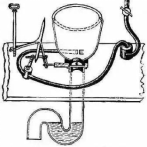Speaking of toilets, our lives cannot do without them, and they are also an important invention that changes the way humans live. Pressing the flush button after using the restroom is our most thoughtless joy every day. For a long time, people were not as clean and neat when it came to convenience. From ancient times to the present, people have been constantly improving the toilet. Toilets have also evolved into a set of evolutionary history.
At the end of the 16th century, British nobleman John Harrington was exiled, but he created a historical miracle during his exile - the first flush toilet. He excitedly installed this invention in the mansion of Queen Elizabeth I, and the queen experienced this unprecedented convenience for the first time, as if opening a window to the future. This forgotten aristocrat, with this innovation, redefined the meaning of hygiene and left a profound impact.

With the sweeping wave of the Industrial Revolution, hygiene issues have gradually attracted people's attention. In the 18th century, Cummins of England lived in such an era, tired of the pungent smell and unsightly sewage systems on the streets, and a flame of innovation ignited in his heart. He was determined to change everything and designed a new type of toilet, equipped with an automatic water tank and a unique "S" - shaped deodorizer pipe.

In 1861, the streets of London were filled with the smoke of factories and the hustle and bustle of the city. In this vibrant city, a plumber named Thomas Clapper harbors a dream of revolution in his heart. Having witnessed the limitations of traditional flush toilets, he decided to no longer be satisfied with the status quo and devote himself to improving this facility. After countless nights of contemplation and experimentation, Klepa finally designed an advanced water-saving flushing system. Imagine him in the workshop, passionately debugging every detail, hoping that this innovation can change people's lives. When his invention was put into use, the discharge of waste finally entered a new era of modernization. Klepa's achievements not only improved hygiene standards, but also paved the way for future toilet technology.

In 19th century England, the emergence of toilets sparked a hygiene revolution and was even seen as a symbol of status by Queen Victoria. In that era, the reform of toilets was not only reflected in technological progress, but also in changes in materials, which became a major watershed in history.
It was not until Chinese porcelain was introduced to Europe that toilet craftsmanship ushered in a new turning point. With Europeans mastering the production technology of porcelain, ceramics gradually extended from the luxury goods field to toilet manufacturing. Porcelain toilets are not only sturdy and durable, but also leak proof, easy to clean, and not prone to bacterial growth, completely changing people's hygiene habits. This innovation is regarded as a major leap in the history of toilet development. In 1883, Thomas Turifeld introduced ceramic toilets to the market, making them the most widely used sanitary ware. This event marks the arrival of a new era, where toilets are no longer just necessities of life, but have become an important symbol of modern hygiene concepts.

The siphon toilet adopts a unique siphon principle, and its internal structure includes a complete S-shaped pipe. When the water level inside the toilet exceeds the high point of the S-shape, a siphon phenomenon is formed, which generates a strong impact and effectively removes the dirt adhered to the toilet bowl wall and quickly discharges it. In addition, the siphon toilet produces extremely low noise during the flushing process, almost approaching a silent state. At the same time, its larger water storage area in the pool wall makes it superior to direct flush toilets in terms of odor prevention performance. Siphon toilets are mainly used in regions such as the United States, Canada, Europe, Russia, the Middle East, Southeast Asia, and South America, with a typical pipe diameter of about 55 millimeters. This design not only enhances the flushing effect, but also improves the comfort of the user experience.

Direct flush toilets achieve efficient flushing by utilizing the powerful thrust generated by compressed air. Its design ensures fast flushing speed and strong sewage discharge capacity, which can effectively remove pollutants. At the same time, it performs well in terms of water consumption and is not prone to leakage. This type of toilet is mainly used in regions such as the Middle East, India, and Southeast Asia, with a pipe diameter typically above 7 centimeters and a range of 90 to 100 millimeters. This structural design not only optimizes the flushing efficiency, but also enhances the overall reliability of the system.

With the continuous advancement of technology and people's pursuit of quality of life, the development of modern toilet flushing structures is ushering in a new chapter. In the future, we can not only look forward to more efficient, water-saving, and intelligent toilet designs, but also see more innovation in environmental protection and comfort. These advancements will improve our daily lives, making the bathroom not just a functional area, but a comfortable space full of wisdom and beauty. The evolution of toilets is allowing us to experience a more convenient and enjoyable way of life.

As a subsidiary of AILANI GROUP, WANLLING primarily responsible for the overseas marketing of all products within the AILANI GROUP portfolio.

